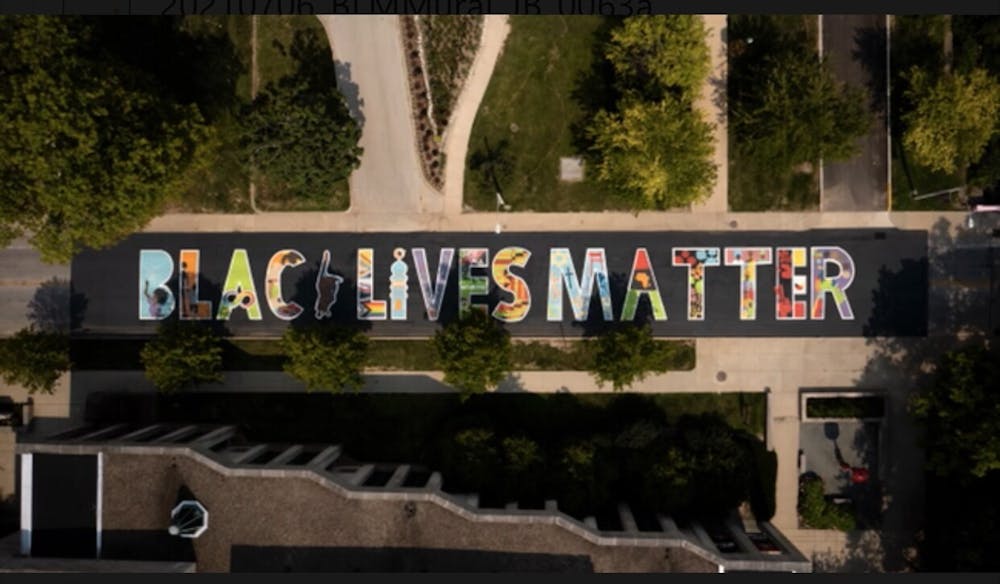Black Lives Matter.
To some, this statement is one of hate and division, but to others it means peace, unity and equality.
When I say Black Lives Matter, I say it with pride because I know what it means to me. This statement acknowledges the systemic oppression and violence which has plagued Black, brown and other marginalized communities for centuries.
Black Lives Matter is a statement of power, reversing the years of torment Black people endured by saying enough is enough. Black people demand to be seen as human and as equal to everyone else. Our lives will no longer be shed in vain. We matter.
IU sophomore and Black Lives Matter mural co-organizer, Joa’Quinn Griffin, said Black Lives Matter means all lives can't matter until Black ones do.
“We have to give a voice to the oppressed and give equity to those who are not privileged based on systemic racism and a system so flawed and against a certain type of people based on looks,” Griffin said.
For the past year, I have been working alongside Griffin to create an all-inclusive Black Lives Matter mural on the campus of Indiana University.
The project began in September of 2020 when Griffin noticed there was a hidden Black Lives Matter flag located on the exterior of the IMU. At the time, Griffin and I served on the diversity, equity and inclusion committee for IU Student Government, which I was the executive director for.
Griffin brought the flag to our committee’s attention and I also noted the existence of the statement “Black Lives Matter” on the lobby steps of the Biddle Hotel, which is located within the IMU. As a result of this conversation, Griffin and I decided it would be best to make a more significant impact on campus with this statement.
From there, Griffin and I decided it would be best to take a more detached approach from IU Student Government to ensure this initiative would be successful. My organization, Black Collegians, came on board from there as the official student organization behind the mural initiative.
The mural was mostly funded through the IU Funding board, as Griffin and I presented our proposal to the committee and were awarded funds to cover costs for supplies, artists and logistics. We also received donations from community members and the Division of Student Affairs.
The idea to make the mural inclusive of other marginalized communities was quite intentional, as we recognize the systemic issues faced by Black people are also faced by others. Griffin and I also understood Black people cannot be in the fight for justice alone and needed to represent unity within the mural.
“We wanted to give a voice to everyone who is underrepresented,” Griffin said. “The mural speaks to intersections and allies and each letter tells its own story.”
Nonetheless, Black people are not monolithic and our identities intertwine with many others. These different identities all conjoined with one another form an identity based on intersectionality.
As a result, each letter represents a different marginalized community. From body positivity to Islamophobia, anyone can walk up to the mural and identity with at least one of the letters and feel seen.
The mural process began with slower motions, and most people we initially talked with were not completely sold on the idea. One major concern was because of the violence experienced last year, the mural would create a rise in the need for security.
However, during the spring of the past academic year, more people began to see the importance of the mural and the statement it would bring to campus.
The mural initiative was approved through the City of Bloomington and IU campus leadership, including former President Michael McRobbie and former Provost Lauren Robel. Griffin and I worked closely with Thomas Morrison, IU capital planning and facilities Vice President, to solidify a location for the mural.
The mural is located at 7th St. and Jordan Ave. between the Neal Marshall Black Culture Center and the Office of the Vice Provost for Diversity, Equity and Multicultural Affairs. The location of the mural was very intentional as Jordan Ave. is being renamed after originally being named after David Starr Jordan, a known eugenicist.
While Griffin and I led the mural initiative, we had others join along in the process. Our artists, Katelyn Scott, Olivia Roath and Ronny Booker all helped bring the vision of the mural to life. Also, Damorion Page, Black Collegians Vice President, played an important role in helping coordinate volunteers and finalize logistics of the mural site.
The mural could not have been completed without the help of over 40 volunteers who came out to work for the three days the mural was being painted.
The painting process spanned from the morning of July 3 to the evening of July 5.
Within the following two weeks, vandals have already begun their acts of hatred to destroy the mural with tire burns. The mural however will not be destroyed, and plans to make minor revisions are currently in works, and will be considered for the years to come.
“This mural is the epitome of inclusion,” Griffin said.






